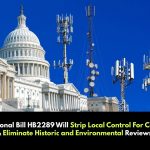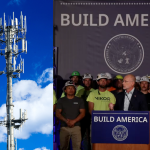
After a much-publicized study this year found
high levels of a toxic chemical class in food wrappings, many of us are eyeing that pizza or to-go salad in a new light.
Experts warn, though, that we shouldn’t just be concerned about exposure from packaged food. The compounds, PFAS, short for per- and polyfluoroalkyl substances, appear to be widespread in our food supply
. PFAS have contaminated dairy and beef farms in Maine and Michigan, and recent testing from the consumer wellness site Mamavation found evidence of the compounds in organic pasta sauces, canola oils and nut butters.
But little is known about how much PFAS Americans are eating. In contrast to drinking water, which is extensively studied, “we have only anecdotal evidence for understanding (other) PFAS exposure sources for the U.S. general population,” Elsie Sunderland, a professor of environmental chemistry at Harvard University,
testified to the federal House Committee on Science, Space and Technology at the end of 2021.
Advocates and some researchers say the U.S. Food and Drug Administration’s efforts to test for and regulate PFAS in food are inadequate, and the agency has likely underestimated health risks from our routine exposure.
More broadly, because PFAS can get into food in many ways, the issue “further highlights the need to stop creating and emitting PFAS globally,” Courtney Carignan, an exposure scientist and environmental epidemiologist at Michigan State University, told EHN.
PFAS in food
PFAS, a group of more than 9,000 man-made compounds, are known for their ability to repel water and oil and withstand high heat. These properties have made them useful in products ranging from firefighting foam to makeup to nonstick pans — and mean they take a long time to break down in the environment and in our bodies, earning them the moniker “forever chemicals.”
This longevity is problematic because some PFAS have been linked to certain kinds of cancer, heart disease, liver damage, lowered vaccine effectiveness, lower birth weights and other health effects. PFAS do “a really good job at crossing the placenta,” Stephanie Eick, an environmental and reproductive epidemiologist at Emory University, told EHN, adding that prenatal exposure to PFAS has been linked to cardiac issues and other problems later in life. Evidence is mounting that some newer PFAS are likely unsafe as well.
The European Union, which has more extensive PFAS testing and regulation than the U.S., has set a low combined suggested weekly food limit for four types of PFAS, estimating that most exceed this safety threshold. The U.S., meanwhile, only has drinking water health advisories for two PFAS compounds.
PFAS can get into the food we eat in a number of ways, from leaching off of food packaging coatings to contamination on farms. In a recent analysis, the Environmental Working Group estimated that the common practice of spreading sewage sludge for fertilizer could have contaminated up to 20 million acres of U.S. croplands with the forever chemicals.
Eick said it’s “very clear” from past studies that eating fish, which can concentrate pollutants found in the water they swim in and in the prey they eat, has been linked to higher PFAS levels.
Follow our collaboration with Mamavation on PFAS testing
Although the evidence is not as strong as for fish and shellfish, Eick said eggs, certain kinds of meat, especially liver and other organ meats and dairy products have also been found to have higher levels of longer chain PFAS in particular. EU scientists have also warned that fruit can contain elevated levels of PFAS.
Food packaging, especially for take-out food, has come under a lot of scrutiny lately as PFAS are commonly used to help grease- and water-proof containers, bags and bakery papers. A seminal study from 2019 found that people who on a daily basis ate microwaved popcorn, which generally comes in coated bags, had “significantly higher” PFAS blood levels, while regularly eating fast food and pizza also tended to be linked to higher PFAS levels. Overall, the risk from eating processed food is not quite as clear yet as eating a contaminated fish because the chemicals have to migrate from the packaging onto the food, noted Eick.
The microwaved popcorn study and others have found that some of the highest PFAS concentrations detected in humans were PFOA and PFOS — two older generation PFAS that are banned in Europe and have been phased out by U.S. manufacturers.
“It is still a major problem, even though we know that they have been phased out” said Eick, who conducted a study that found elevated levels of those and other older PFAS in pregnant people who ate fish and other animal products.
PFAS in organic food

The consumer wellness site Mamavation has been testing a range of consumer products for fluorine, an indicator for PFAS, at an Environmental Protection Agency-certified lab. Leah Segedie, founder of Mamavation, told EHN that she has focused the testing on organic food and products marketed as green or natural, given that people buy those products in part because they think they’re safer.
Recently published testing from Mamavation found that four out of 55 organic pasta sauces tested last year had fluorine, while five out of 17 canola oils, and four out of 33 nut butters had the PFAS indicator. Subsequent testing of a smaller number of sauces and oils this year did not turn up any evidence of the compounds.
EHN.org partially funded the testing. Pete Myers, chief scientist of Environmental Health Sciences, which publishes Environmental Health News, reviewed the findings.
Linda Birnbaum, former director at the National Institute of Environmental Health Sciences and the National Toxicology Program and a scholar in residence at the Nicholas School of the Environment at Duke University, told Mamavation that while “the good news is that only 8% of the tomato and pasta sauces (tested) did not have any PFAS,” there would ideally be no PFAS in our food as the compounds can be toxic at low doses.
Michigan State University’s Carignan said that her initial thoughts on the Mamavation pasta sauce testing were that the results could be false positives, as there’s a number of challenges with testing for PFAS in food. But she added that researchers know that produce with higher water content, like tomatoes, can absorb more of the compounds, so “it’s possible that the results are real.”
Limitations in the FDA’s testing of PFAS in food
The FDA’s effort to test for PFAS in food highlights some of the testing challenges. In 2019, the agency developed a new method to test for 16 out of the estimated 9,000+ PFAS in a range of common foods. The agency initially found the compounds in 14 out of 91 samples — including shockingly high levels in a piece of chocolate cake.
The FDA later took back those results, saying that it appeared that and the other result for chocolate milk were false positives as the test couldn’t distinguish between the compound PFPeA and chocolate. The agency also raised its detection limit, saying that there were only two foods that it could confidently say had PFAS. The FDA has said that the sample size in this study was too small to draw conclusions from.
Some environmental health researchers and advocates have raised concerns about the FDA’s testing efforts to date. The agency should test for the specific PFAS found in food packaging, not just those found in the environment, Melanie Benesh, an attorney with the Environmental Working Group, told EHN.
Additionally, the FDA should reconsider its current detection limit, given that PFAS can be harmful in very low amounts, she added. “We really think that they should be, at a minimum, disclosing all of their detection so that we have a fuller picture of exactly how many foods are testing positive for some level of PFAS, even if it’s at low levels.”
Overall, there’s an “absence of validated methods” to test for PFAS in food, according to Charles Neslund, scientific officer for Eurofins USA, a leading PFAS testing lab, although researchers are working to address this. The FDA, for example, is expanding its method to test for four additional PFAS. Scientists are also working to improve methods to test for fluorine in food packaging to quickly screen for the presence of PFAS.
An emerging challenge is that limited methods exist to test for PFAS “precursors” — that is, compounds that break down in the environment or in our bodies into PFAS.
Steps to reduce health harms of PFAS in food

So far seven states — California, Maine, Connecticut, New York, Vermont, Minnesota and Washington — are following Denmark in banning PFAS from food packaging, with the soonest of these bans going into effect in New York at the end of this year. In the meantime, a new certification tracks whether single-use food containers have PFAS, BPA and other toxics.
In addition, a growing number of restaurants and fast food chains have started to ban PFAS from food packaging. Burger King, Chipotle, Taco Bell, Wendy’s, McDonald’, Sweetgreen and other chains have already banned or will soon eliminate food waste from packaging — although recent testing from Consumer Reports found that many companies with bans already in place still have the compounds in their packaging.
Keith Vorst, an associate professor of food science at Iowa State University, told EHN that challenges remain in completely eliminating PFAS from food packaging, including a lack of safe and inexpensive grease proofing alternatives. Additionally, makers of recycled-plastic food containers are finding trace amounts of PFAS in their products even when the compounds are not added as a coating.
If PFAS in food packaging bans move forward, there will need to be a consensus on what counts as intentionally added PFAS versus background contamination, he added. “I haven’t heard a single one of the companies I work with say ‘there’s a future for fluorochemistry in our products.’ ”
In general, environmental health experts would like to see federal U.S. regulatory agencies cooperate to better address PFAS exposure research and issue appropriate health warnings. The EPA could, for example, conduct further testing of the sludge generated at wastewater treatment plants and crop fields where it was spread, said Benesh. “The extent to which food is being contaminated with sludge is, I think, dramatically underestimated, and the more we test, the more we’re going to realize how big of a problem this is,” Benesh said.
Michigan now requires businesses, like paper mills and chemical companies, that create wastewater that’s especially high in PFAS to pre-treat that waste before it goes to public treatment plants.
There are some simple measures that pregnant people and anyone concerned about PFAS exposure can take, such as cutting down how much fish and other animal products they consume, Eick said. She also suggests tossing out any nonstick pans with scratches on them and using the Environmental Working Group’s Skin Deep database to make sure your personal care products are low-risk. Despite the widespread prevalence of PFAS, “I do really feel like it is possible to minimize exposure,” Eick added.
Follow our PFAS testing project with Mamavation at the series landing page.
Want to know more about PFAS? Check out our comprehensive guide.
Have something you want tested for PFAS? Let us know and write us at feedback@ehn.org.
Banner photo credit: Rosalind Chang/Unsplash





